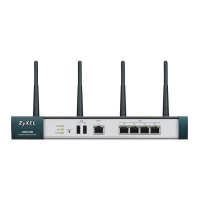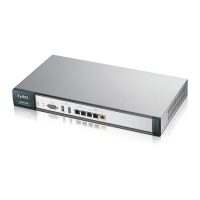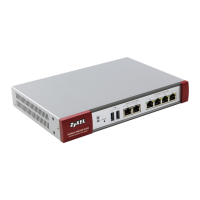Chapter 30 Bandwidth Management
UAG4100 User’s Guide
290
The following table describes the labels in this screen.
Table 135 Configuration > Bandwidth Management > Add/Edit
LABEL DESCRIPTION
Create new
Object
Use to configure any new settings objects that you need to use in this screen.
Enable Select this check box to turn on this policy.
Description Enter a description of this policy. You can use alphanumeric and ()+/:=?!*#@$_%-
characters, and it can be up to 60 characters long.
BWM Type Select Shared to have users that match this policy to share the bandwidth configured in
this policy.
Select Per user to allow every user that matches this policy to use up to the bandwidth
configured in this policy.
User Select a user name or user group to which to apply the policy. Use Create new Object if
you need to configure a new user account. Select any to apply the policy for every user.
Schedule Select a schedule that defines when the policy applies or select Create new Object to
configure a new one (see Chapter 35 on page 331 for details). Otherwise, select none to
make the policy always effective.
Incoming
Interface
Select the source interface of the traffic to which this policy applies.
Outgoing
Interface
Select the destination interface of the traffic to which this policy applies.
Source Select a source address or address group for whom this policy applies. Use Create new
Object if you need to configure a new one. Select any if the policy is effective for every
source.
Destination Select a destination address or address group for whom this policy applies. Use Create
new Object if you need to configure a new one. Select any if the policy is effective for
every destination.
DSCP Code Select a DSCP code point value of incoming or outgoing packets to which this policy applies
or select User Define to specify another DSCP code point. The lower the number the
higher the priority with the exception of 0 which is usually given only best-effort
treatment.
any means all DSCP value or no DSCP marker.
default means traffic with a DSCP value of 0. This is usually best effort traffic.
The “af” choices stand for Assured Forwarding. The number following the “af” identifies
one of four classes and one of three drop preferences. See Section 12.4 on page 169 for
more details.
User-Defined
DSCP Code
Use this field to specify a custom DSCP code point.
Service Object Select a service or service group to identify the type of traffic to which this policy applies.
DSCP Marking Set how the UAG handles the DSCP value of the incoming and outgoing packets that match
this policy.
Inbound
Marking
Outbound
Marking
Inbound refers to the traffic the UAG sends to a connection’s initiator. Outbound refers to
the traffic the UAG sends out from a connection’s initiator.
Select one of the pre-defined DSCP values to apply or select User Defined to specify
another DSCP value. The “af” choices stand for Assured Forwarding. The number following
the “af” identifies one of four classes and one of three drop preferences. See Section 12.4
on page 169 for more details.
Select preserve to have the UAG keep the packets’ original DSCP value.
Select default to have the UAG set the DSCP value of the packets to 0.

